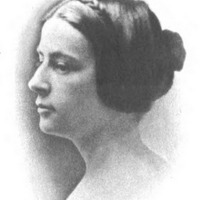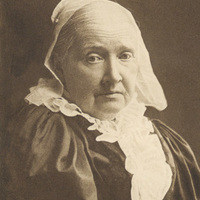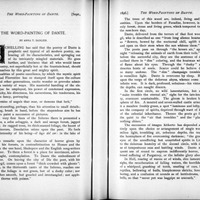-
 Perry Lowe, Martha A. (1829-1902)
Perry Lowe, Martha A. (1829-1902) Martha Perry Lowe was an American writer of poetry and prose, as well as a social activist and organizer. She supported women's rights, education, and Unitarian organizations.
Born in New Hampshire in 1829, her parents were General Justus Perry and Hannah Wood. She was a descendant of William Wood, the supposed author of New England's Prospects, who left England and settled in Concord in 1638. At the age of 15, Lowe was sent to Sedgwick's School for Young Ladies. After her graduation, she spent a winter in the West Indies, and the following year was passed in Madrid with her brother, who was a member of the Spanish legation.
In 1857, she married the Rev. Charles Lowe who died in 1874, and at the time of his death was a member of the Somerville school committee. In 1871, when the family went to Europe, Lowe corresponded regularly for the Liberal Christian. In Somerville, she was connected with the Unitarian Review. She was the author of several books of prose and poetry; the most noted ones include The Olive and the Pine, Love in Spain, and a Memoir of Charles Lowe.
She was interested in many public and private philanthropies, but her chief interests were in the public schools. She was among the first to advocate the teaching of cooking and sewing, and at her suggestion a sum of money was raised for that purpose. She was one of the founders of the Educational Union in Somerville, one of whose duties was a regular visitation of the schools by its members. She was a member of the Society of American Authors of New York, the Authors' Club of Boston, the Woman's Education Association, and the Unitarian Church Temperance Society, as well as an honorary member of the Castilian Club, of the Heptorean Club, of the Teachers' Annuity Guild, honorary president of the Woman Suffrage League, a director of the Massachusetts Suffrage Association, president of the Woman's Alliance of the First Unitarian Church, and a member of the Cambridge Branch of the Indian Association.
She died in Massachusetts in 1902.
-
Kemble, Frances Anne (1809-1893)
Frances Anne Kemble was a British actress from a theatre family in the early and mid-19th century. She was a well-known and popular writer and abolitionist whose published works included plays, poetry, eleven volumes of memoirs, travel writing, and works about the theatre.
A member of the famous Kemble theatrical family, Fanny was the eldest daughter of the actor Charles Kemble and his Viennese-born wife, the former Marie Therese De Camp. She was a niece of the noted tragedienne Sarah Siddons and of the famous actor John Philip Kemble. Her younger sister was the opera singer Adelaide Kemble. Fanny was born in London and educated chiefly in France. In 1821, Fanny Kemble departed to boarding school in Paris to study art and music as befitted the child of the most celebrated artistic family in England at that time. In addition to literature and society, at Mrs. Lamb's Academy in the Rue d'Angoulême, Champs Elysées, Fanny received her first real personal exposure to the stage performing staged readings for students' parents during her time at school. As an adolescent, Kemble spent time studying literature and poetry, in particular the work of Lord Byron. In 1827, Kemble wrote her first five-act play, Francis the First. It was met with critical acclaim from multiple quarters. On 26 October 1829, at the age of 19, Kemble first appeared on the stage as Juliet in Romeo and Juliet at Covent Garden Theatre. In 1832, Kemble accompanied her father on a theatrical tour of the United States. While in Boston in 1833, she journeyed to Quincy to witness the revolutionary technology of the first commercial railroad in the United States. She had previously accompanied George Stephenson on a test of the Liverpool and Manchester before its opening in England and described this in a letter written in early 1830. The Granite Railway was among many sights she recorded in her journal. On 7 June 1834, Kemble retired from the stage to marry a wealthy Philadelphian, Pierce Mease Butler, grandson of U.S. Senator Pierce Butler, whom she had met on an American acting tour with her father in 1832. Kemble retired from her acting career upon her marriage in 1834, but after her separation, she returned to acting as a solo platform performer, beginning her first American tour in 1849. During her readings, she rose to focus on presenting edited works of Shakespeare, though, unlike others, she insisted on representing his entire canon, ultimately building her repertoire to 25 of his plays. She performed in Britain and the United States, concluding her career as a platform performer in 1868. Kemble wrote two plays, Francis the First (1832) and The Star of Seville (1837). She also published a volume of poems (1844). She published the first volume of her memoirs, Journal, in 1835, shortly after her marriage. She waited until 1863, during the American Civil War, to publish her anti-slavery Journal of a Residence on a Georgian Plantation in 1838–1839. After separating from Butler in the 1840s, Kemble travelled in Italy and wrote a two-volume book on this time, A Year of Consolation (1847). In 1863, Kemble also published a volume of plays, including translations from Alexandre Dumas père and Friedrich Schiller. Other memoirs followed these: Records of a Girlhood (1878); Records of Later Life (1882); Far Away and Long Ago (1889); and Further Records (1891). Kemble died in London in 1893.
-
 Ward Howe, Julia (1819-1910)
Ward Howe, Julia (1819-1910) Julia Ward was born in New York City on May 27, 1819. She was the fourth of seven children. Her father Samuel Ward III was a Wall Street stockbroker, banker, and strict Calvinist Episcopalian. Her mother was the poet Julia Rush Cutler Ward, related to Francis Marion, the "Swamp Fox" of the American Revolution. She died during childbirth when Howe was five.
Howe was educated by private tutors and schools for young ladies until she was sixteen. Her eldest brother, Samuel Cutler Ward, traveled in Europe and brought home a private library. She had access to these books, many contradicting the Calvinistic view. She became well-read, though social as well as scholarly. She met, because of her father's status as a successful banker, Charles Dickens, Charles Sumner, and Margaret Fuller.
She attended lectures, studied foreign languages, and wrote plays and dramas. Before her marriage, Howe had published essays on Goethe, Schiller and Lamartine in the New York Review and Theological Review.
Her first volume of poetry, Passion-Flowers was published anonymously in 1853. Howe's being a published author troubled her husband greatly, especially due to the fact that her poems many times had to do with critiques of women's roles as wives, her own marriage, and women's place in society. Their marriage problems escalated to the point where they separated in 1852. Howe's writing and social activism were greatly shaped by her upbringing and married life.
She was inspired to write "The Battle Hymn of the Republic" after she and her husband visited Washington, D.C., and met Abraham Lincoln at the White House in November 1861.
She helped found the New England Women's Club and the New England Woman Suffrage Association. She served as president for nine years beginning in 1868. In 1869, she became co-leader of the American Woman Suffrage Association. Then, in 1870, she became president of the New England Women's Club. After her husband's death in 1876, she focused more on her interests in reform. In 1877 Howe was one of the founders of the Women's Educational and Industrial Union in Boston. She was the founder and from 1876 to 1897 president of the Association of American Women, which advocated for women's education.
In 1872, she became the editor of Woman's Journal, a widely-read suffragist magazine founded in 1870 by Lucy Stone and Henry B. Blackwell. In 1881, Howe was elected president of the Association for the Advancement of Women.
Howe died of pneumonia on October 17, 1910, at her Portsmouth home, Oak Glen at the age of 91. She is buried in the Mount Auburn Cemetery in Cambridge, Massachusetts.
After her death, her children collaborated on a biography, published in 1916. It won the Pulitzer Prize for Biography. In 1987, she was honored by the U.S. Postal Service with a 14¢ Great Americans series postage stamp.
-
 Locke Starkweather, Jane Ermina (1805-1859)
Locke Starkweather, Jane Ermina (1805-1859) A deacon's daughter, Jane Starkweather Locke reflects in her work the religious and patriotic idealism nurtured in her childhood home. Her uncle Ezra was a Massachusetts state senator and a member of the Constitutional Convention of 1820, as was Locke's father-in-law, John Locke. She was the youngest of 10 children. Locke followed her husband to New York shortly after their marriage. The first of their seven children was born there; three of the children were to die in early childhood, and only one, Grace LeBaron Upham, was to survive to adulthood. The family settled in Lowell (1833) and in Boston (1849). While John pursued a career in business and government service, Jane cared for the children and pursued her own literary interests.
Locke's first collection of poetry is Miscellaneous Poems (1842). In the preface, the author tells us that the poems were written "for the most part…to relieve the soul of what would cumber it unuttered." The poems range in subject from reminiscences of her childhood home to expressions of love and concern for husband and children, and beyond this family circle to acknowledgements of the genial accomplishments of others—mostly contemporaries. […] Between 1850 and 1854, Locke worked as a newspaper correspondent for the Boston Journal and the Daily Atlas. In the same period, she also worked for the James Monroe Publishing Company, writing prefaces for the English publications that they reproduced in this country.
-
 Junkin, Margaret (1820-1897)
Junkin, Margaret (1820-1897) She was born in Milton, Pennsylvania, in 1820.
Her father was George Junkin, a Presbyterian minister and college president. She learned Latin and Ancient Greek at the age of twelve. She married Major John Thomas Lewis Preston in 1857, a professor of Latin at Virginia Military Institute. Her sister, Elinor (Ellie), had in 1853 married Thomas "Stonewall" Jackson, a colleague of Preston's at VMI. Major Preston served on the staff of Stonewall Jackson during the Civil War.
She wrote many volumes of prose and poetry, and published some of her writing in the Southern Literary Messenger and Graham's Magazine.
She also published a few articles in Harper's Magazine. Preston's 1856 novel Silverwood is a subtle exploration of the clash between traditional values of honor and family and the new market economy that was sweeping through the United States and the Shenandoah Valley.
She is remembered for espousing the Confederacy in her poems, and she was known informally as the Poet Laureate of the Confederacy. She became blind in the late 1880s, and died in Baltimore in 1897.
-
 Freeman Clarke, Sarah Anne (1808-1896)
Freeman Clarke, Sarah Anne (1808-1896) Clarke was born in Massachusetts in 1808. Her brother was the Unitarian minister James Freeman Clarke. She was involved in the Transcendentalist Movement.
In 1843 Clarke traveled with her brother James and mutual friend Margaret Fuller to the area of the Great Lakes and the territories of Wisconsin and Illinois. Fuller wrote and Clarke illustrated the journey in the book Summer on the Lakes in 1843. Clarke exhibited her work at the Woman's Building at the 1893 World's Columbian Exposition in Chicago, Illinois.
She wrote for the prominent American peridiocals, including The Dial and the Century Magazine.
She died in 1896.
-
 Frances Erskine Inglis, (afterwards Madame Calderón de la Barca)
Frances Erskine Inglis, (afterwards Madame Calderón de la Barca)
-
Dante's Banquet
-
 "The word-painting of Dante"
"The word-painting of Dante"
-
 "Some glimpses of the unity of truth in Dante"
"Some glimpses of the unity of truth in Dante"
-
An index to the classical and mythological references of the Divine Comedy, preceded by an essay upon Dante's use of mythological material
-
Life of the spirit in the modern English poets
-
"The angels of Dante"
-
"The 'Paradise' of Dante, introductory cantos"
-
Paolo and Francesca
-
Is polite society polite? and other essays
-
A woman's view of Dante
-
 "The young Dante to the lady at the window (From La vita nuova) ["Color d'amore, e di pietà sembranti"]"
"The young Dante to the lady at the window (From La vita nuova) ["Color d'amore, e di pietà sembranti"]"
-
A study of Dante
-
Lettera a Giordano Perticari-Lettera a Salvatore Betti
-
Sonnets and lyrics
-
All'ombra di Dante Alighieri
-
Twelve lessons on Dante's Divina Commedia
-
The vision of Dante; a story for little children and a talk to their mothers. Illustrated by Walter Crane
-
Dante;carme biblico
 Perry Lowe, Martha A. (1829-1902) Martha Perry Lowe was an American writer of poetry and prose, as well as a social activist and organizer. She supported women's rights, education, and Unitarian organizations. Born in New Hampshire in 1829, her parents were General Justus Perry and Hannah Wood. She was a descendant of William Wood, the supposed author of New England's Prospects, who left England and settled in Concord in 1638. At the age of 15, Lowe was sent to Sedgwick's School for Young Ladies. After her graduation, she spent a winter in the West Indies, and the following year was passed in Madrid with her brother, who was a member of the Spanish legation. In 1857, she married the Rev. Charles Lowe who died in 1874, and at the time of his death was a member of the Somerville school committee. In 1871, when the family went to Europe, Lowe corresponded regularly for the Liberal Christian. In Somerville, she was connected with the Unitarian Review. She was the author of several books of prose and poetry; the most noted ones include The Olive and the Pine, Love in Spain, and a Memoir of Charles Lowe. She was interested in many public and private philanthropies, but her chief interests were in the public schools. She was among the first to advocate the teaching of cooking and sewing, and at her suggestion a sum of money was raised for that purpose. She was one of the founders of the Educational Union in Somerville, one of whose duties was a regular visitation of the schools by its members. She was a member of the Society of American Authors of New York, the Authors' Club of Boston, the Woman's Education Association, and the Unitarian Church Temperance Society, as well as an honorary member of the Castilian Club, of the Heptorean Club, of the Teachers' Annuity Guild, honorary president of the Woman Suffrage League, a director of the Massachusetts Suffrage Association, president of the Woman's Alliance of the First Unitarian Church, and a member of the Cambridge Branch of the Indian Association. She died in Massachusetts in 1902.
Perry Lowe, Martha A. (1829-1902) Martha Perry Lowe was an American writer of poetry and prose, as well as a social activist and organizer. She supported women's rights, education, and Unitarian organizations. Born in New Hampshire in 1829, her parents were General Justus Perry and Hannah Wood. She was a descendant of William Wood, the supposed author of New England's Prospects, who left England and settled in Concord in 1638. At the age of 15, Lowe was sent to Sedgwick's School for Young Ladies. After her graduation, she spent a winter in the West Indies, and the following year was passed in Madrid with her brother, who was a member of the Spanish legation. In 1857, she married the Rev. Charles Lowe who died in 1874, and at the time of his death was a member of the Somerville school committee. In 1871, when the family went to Europe, Lowe corresponded regularly for the Liberal Christian. In Somerville, she was connected with the Unitarian Review. She was the author of several books of prose and poetry; the most noted ones include The Olive and the Pine, Love in Spain, and a Memoir of Charles Lowe. She was interested in many public and private philanthropies, but her chief interests were in the public schools. She was among the first to advocate the teaching of cooking and sewing, and at her suggestion a sum of money was raised for that purpose. She was one of the founders of the Educational Union in Somerville, one of whose duties was a regular visitation of the schools by its members. She was a member of the Society of American Authors of New York, the Authors' Club of Boston, the Woman's Education Association, and the Unitarian Church Temperance Society, as well as an honorary member of the Castilian Club, of the Heptorean Club, of the Teachers' Annuity Guild, honorary president of the Woman Suffrage League, a director of the Massachusetts Suffrage Association, president of the Woman's Alliance of the First Unitarian Church, and a member of the Cambridge Branch of the Indian Association. She died in Massachusetts in 1902. Ward Howe, Julia (1819-1910) Julia Ward was born in New York City on May 27, 1819. She was the fourth of seven children. Her father Samuel Ward III was a Wall Street stockbroker, banker, and strict Calvinist Episcopalian. Her mother was the poet Julia Rush Cutler Ward, related to Francis Marion, the "Swamp Fox" of the American Revolution. She died during childbirth when Howe was five. Howe was educated by private tutors and schools for young ladies until she was sixteen. Her eldest brother, Samuel Cutler Ward, traveled in Europe and brought home a private library. She had access to these books, many contradicting the Calvinistic view. She became well-read, though social as well as scholarly. She met, because of her father's status as a successful banker, Charles Dickens, Charles Sumner, and Margaret Fuller. She attended lectures, studied foreign languages, and wrote plays and dramas. Before her marriage, Howe had published essays on Goethe, Schiller and Lamartine in the New York Review and Theological Review. Her first volume of poetry, Passion-Flowers was published anonymously in 1853. Howe's being a published author troubled her husband greatly, especially due to the fact that her poems many times had to do with critiques of women's roles as wives, her own marriage, and women's place in society. Their marriage problems escalated to the point where they separated in 1852. Howe's writing and social activism were greatly shaped by her upbringing and married life. She was inspired to write "The Battle Hymn of the Republic" after she and her husband visited Washington, D.C., and met Abraham Lincoln at the White House in November 1861. She helped found the New England Women's Club and the New England Woman Suffrage Association. She served as president for nine years beginning in 1868. In 1869, she became co-leader of the American Woman Suffrage Association. Then, in 1870, she became president of the New England Women's Club. After her husband's death in 1876, she focused more on her interests in reform. In 1877 Howe was one of the founders of the Women's Educational and Industrial Union in Boston. She was the founder and from 1876 to 1897 president of the Association of American Women, which advocated for women's education. In 1872, she became the editor of Woman's Journal, a widely-read suffragist magazine founded in 1870 by Lucy Stone and Henry B. Blackwell. In 1881, Howe was elected president of the Association for the Advancement of Women. Howe died of pneumonia on October 17, 1910, at her Portsmouth home, Oak Glen at the age of 91. She is buried in the Mount Auburn Cemetery in Cambridge, Massachusetts. After her death, her children collaborated on a biography, published in 1916. It won the Pulitzer Prize for Biography. In 1987, she was honored by the U.S. Postal Service with a 14¢ Great Americans series postage stamp.
Ward Howe, Julia (1819-1910) Julia Ward was born in New York City on May 27, 1819. She was the fourth of seven children. Her father Samuel Ward III was a Wall Street stockbroker, banker, and strict Calvinist Episcopalian. Her mother was the poet Julia Rush Cutler Ward, related to Francis Marion, the "Swamp Fox" of the American Revolution. She died during childbirth when Howe was five. Howe was educated by private tutors and schools for young ladies until she was sixteen. Her eldest brother, Samuel Cutler Ward, traveled in Europe and brought home a private library. She had access to these books, many contradicting the Calvinistic view. She became well-read, though social as well as scholarly. She met, because of her father's status as a successful banker, Charles Dickens, Charles Sumner, and Margaret Fuller. She attended lectures, studied foreign languages, and wrote plays and dramas. Before her marriage, Howe had published essays on Goethe, Schiller and Lamartine in the New York Review and Theological Review. Her first volume of poetry, Passion-Flowers was published anonymously in 1853. Howe's being a published author troubled her husband greatly, especially due to the fact that her poems many times had to do with critiques of women's roles as wives, her own marriage, and women's place in society. Their marriage problems escalated to the point where they separated in 1852. Howe's writing and social activism were greatly shaped by her upbringing and married life. She was inspired to write "The Battle Hymn of the Republic" after she and her husband visited Washington, D.C., and met Abraham Lincoln at the White House in November 1861. She helped found the New England Women's Club and the New England Woman Suffrage Association. She served as president for nine years beginning in 1868. In 1869, she became co-leader of the American Woman Suffrage Association. Then, in 1870, she became president of the New England Women's Club. After her husband's death in 1876, she focused more on her interests in reform. In 1877 Howe was one of the founders of the Women's Educational and Industrial Union in Boston. She was the founder and from 1876 to 1897 president of the Association of American Women, which advocated for women's education. In 1872, she became the editor of Woman's Journal, a widely-read suffragist magazine founded in 1870 by Lucy Stone and Henry B. Blackwell. In 1881, Howe was elected president of the Association for the Advancement of Women. Howe died of pneumonia on October 17, 1910, at her Portsmouth home, Oak Glen at the age of 91. She is buried in the Mount Auburn Cemetery in Cambridge, Massachusetts. After her death, her children collaborated on a biography, published in 1916. It won the Pulitzer Prize for Biography. In 1987, she was honored by the U.S. Postal Service with a 14¢ Great Americans series postage stamp. Locke Starkweather, Jane Ermina (1805-1859) A deacon's daughter, Jane Starkweather Locke reflects in her work the religious and patriotic idealism nurtured in her childhood home. Her uncle Ezra was a Massachusetts state senator and a member of the Constitutional Convention of 1820, as was Locke's father-in-law, John Locke. She was the youngest of 10 children. Locke followed her husband to New York shortly after their marriage. The first of their seven children was born there; three of the children were to die in early childhood, and only one, Grace LeBaron Upham, was to survive to adulthood. The family settled in Lowell (1833) and in Boston (1849). While John pursued a career in business and government service, Jane cared for the children and pursued her own literary interests. Locke's first collection of poetry is Miscellaneous Poems (1842). In the preface, the author tells us that the poems were written "for the most part…to relieve the soul of what would cumber it unuttered." The poems range in subject from reminiscences of her childhood home to expressions of love and concern for husband and children, and beyond this family circle to acknowledgements of the genial accomplishments of others—mostly contemporaries. […] Between 1850 and 1854, Locke worked as a newspaper correspondent for the Boston Journal and the Daily Atlas. In the same period, she also worked for the James Monroe Publishing Company, writing prefaces for the English publications that they reproduced in this country.
Locke Starkweather, Jane Ermina (1805-1859) A deacon's daughter, Jane Starkweather Locke reflects in her work the religious and patriotic idealism nurtured in her childhood home. Her uncle Ezra was a Massachusetts state senator and a member of the Constitutional Convention of 1820, as was Locke's father-in-law, John Locke. She was the youngest of 10 children. Locke followed her husband to New York shortly after their marriage. The first of their seven children was born there; three of the children were to die in early childhood, and only one, Grace LeBaron Upham, was to survive to adulthood. The family settled in Lowell (1833) and in Boston (1849). While John pursued a career in business and government service, Jane cared for the children and pursued her own literary interests. Locke's first collection of poetry is Miscellaneous Poems (1842). In the preface, the author tells us that the poems were written "for the most part…to relieve the soul of what would cumber it unuttered." The poems range in subject from reminiscences of her childhood home to expressions of love and concern for husband and children, and beyond this family circle to acknowledgements of the genial accomplishments of others—mostly contemporaries. […] Between 1850 and 1854, Locke worked as a newspaper correspondent for the Boston Journal and the Daily Atlas. In the same period, she also worked for the James Monroe Publishing Company, writing prefaces for the English publications that they reproduced in this country. Junkin, Margaret (1820-1897) She was born in Milton, Pennsylvania, in 1820. Her father was George Junkin, a Presbyterian minister and college president. She learned Latin and Ancient Greek at the age of twelve. She married Major John Thomas Lewis Preston in 1857, a professor of Latin at Virginia Military Institute. Her sister, Elinor (Ellie), had in 1853 married Thomas "Stonewall" Jackson, a colleague of Preston's at VMI. Major Preston served on the staff of Stonewall Jackson during the Civil War. She wrote many volumes of prose and poetry, and published some of her writing in the Southern Literary Messenger and Graham's Magazine. She also published a few articles in Harper's Magazine. Preston's 1856 novel Silverwood is a subtle exploration of the clash between traditional values of honor and family and the new market economy that was sweeping through the United States and the Shenandoah Valley. She is remembered for espousing the Confederacy in her poems, and she was known informally as the Poet Laureate of the Confederacy. She became blind in the late 1880s, and died in Baltimore in 1897.
Junkin, Margaret (1820-1897) She was born in Milton, Pennsylvania, in 1820. Her father was George Junkin, a Presbyterian minister and college president. She learned Latin and Ancient Greek at the age of twelve. She married Major John Thomas Lewis Preston in 1857, a professor of Latin at Virginia Military Institute. Her sister, Elinor (Ellie), had in 1853 married Thomas "Stonewall" Jackson, a colleague of Preston's at VMI. Major Preston served on the staff of Stonewall Jackson during the Civil War. She wrote many volumes of prose and poetry, and published some of her writing in the Southern Literary Messenger and Graham's Magazine. She also published a few articles in Harper's Magazine. Preston's 1856 novel Silverwood is a subtle exploration of the clash between traditional values of honor and family and the new market economy that was sweeping through the United States and the Shenandoah Valley. She is remembered for espousing the Confederacy in her poems, and she was known informally as the Poet Laureate of the Confederacy. She became blind in the late 1880s, and died in Baltimore in 1897. Freeman Clarke, Sarah Anne (1808-1896) Clarke was born in Massachusetts in 1808. Her brother was the Unitarian minister James Freeman Clarke. She was involved in the Transcendentalist Movement. In 1843 Clarke traveled with her brother James and mutual friend Margaret Fuller to the area of the Great Lakes and the territories of Wisconsin and Illinois. Fuller wrote and Clarke illustrated the journey in the book Summer on the Lakes in 1843. Clarke exhibited her work at the Woman's Building at the 1893 World's Columbian Exposition in Chicago, Illinois. She wrote for the prominent American peridiocals, including The Dial and the Century Magazine. She died in 1896.
Freeman Clarke, Sarah Anne (1808-1896) Clarke was born in Massachusetts in 1808. Her brother was the Unitarian minister James Freeman Clarke. She was involved in the Transcendentalist Movement. In 1843 Clarke traveled with her brother James and mutual friend Margaret Fuller to the area of the Great Lakes and the territories of Wisconsin and Illinois. Fuller wrote and Clarke illustrated the journey in the book Summer on the Lakes in 1843. Clarke exhibited her work at the Woman's Building at the 1893 World's Columbian Exposition in Chicago, Illinois. She wrote for the prominent American peridiocals, including The Dial and the Century Magazine. She died in 1896. Frances Erskine Inglis, (afterwards Madame Calderón de la Barca)
Frances Erskine Inglis, (afterwards Madame Calderón de la Barca)  "The word-painting of Dante"
"The word-painting of Dante"  "Some glimpses of the unity of truth in Dante"
"Some glimpses of the unity of truth in Dante"  "The young Dante to the lady at the window (From La vita nuova) ["Color d'amore, e di pietà sembranti"]"
"The young Dante to the lady at the window (From La vita nuova) ["Color d'amore, e di pietà sembranti"]"